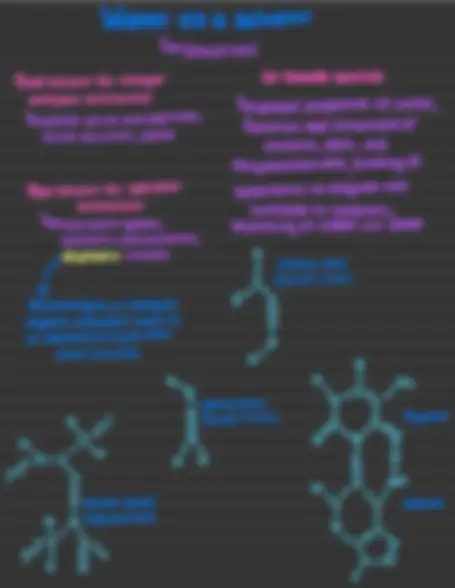



Study with the several resources on Docsity

Earn points by helping other students or get them with a premium plan


Prepare for your exams
Study with the several resources on Docsity

Earn points to download
Earn points by helping other students or get them with a premium plan
Community
Ask the community for help and clear up your study doubts
Discover the best universities in your country according to Docsity users
Free resources
Download our free guides on studying techniques, anxiety management strategies, and thesis advice from Docsity tutors
The crucial role of water as the medium for life, highlighting its unique properties that support biological processes. It details how water's structure, dictated by the octet rule and resulting in a distorted tetrahedron geometry, leads to its dipole moment and ability to form hydrogen bonds. These hydrogen bonds are essential for water's solvent capabilities, allowing it to dissolve charged and polar substances while excluding nonpolar ones. The document further explains how water's properties influence the structure and function of proteins, nucleic acids, and membranes, as well as its involvement in various biochemical interactions, such as enzyme-substrate binding and mrna-trna matching. It also touches on the cooperative effect of hydrogen bonding, which contributes to water's high boiling point, melting point, and surface tension, making it an indispensable component of biological systems. The document also shows some chemical structures.
Typology: Study notes
1 / 3

This page cannot be seen from the preview
Don't miss anything!


Life evolved^ in^ water^ due^ to^ the^ protection^ it^ provides^ from
chemical reactions^ occur^ in^ aqueous environments^ ; Water is a critical determinant^ of^ the^ structure^ and^ function^ of Proteins,nucleic acids^ , and^ membrane The (^) octect rule dictates^ that^ there^ are^4 electron pairs around^ an^ oxygen atom^ in^ water^ ~
. B@ These electrons are^ in^ four^ Sp
(^) orbitals Two of these (^) pairs (^) covalently link two^ hydrogen (^) •^ •
The (^) electronegativity a-+ne^ oxygen atom induces^ a^ net^ dipole^ moment Because (^) of the (^) dipole moment,water can^ serve as both^ a (^) hydrogen bond^ donor^ and^ acceptor
Hydrogen Bonds R
1 Or^ charge -^ dipole^ interactions^ that^ arise [ strong hydrogen
~ bond^ between^ a^ covalently bound^ hydrogen and^ lone pair of^ electrons p 1 Typically involve (^2) electronegative % ^ Weaker atoms^ ;frequently^ nitrogen^ and (^) oxygen p
hydrogen bond Hydrogen bonds (^) are (^) strongest when^ the bonded molecules^ allow for^ linear 3 atoms involved (^) are (^) bonding patterns EE•÷••:•.¥• in a^ line k⑨qg%a B-ioBIFH.as.IM#I*qi-iEBEM water can serve^ as an H^ donor^ and ④⑧%•¥•q;É¥¥
§q•i¥§•?% " *÷←¥É•••%¥a÷ Hydrogen bonding^ in^ water •_•^ :•μ is (^) cooperative (^) up to 4 H- (^) bonds (^) per water molecule give water^ its cooperative effect^
of (^) a (^) hydrogen-bond^ If^ it point and^ Large surface concurrently acts^ as^
acceptor for^ a^ 2nd^ hydrogen^ H-bonds between (^) neighboring molecules bond (^) are weak C.20k) 1m01) relative to^ the^ H